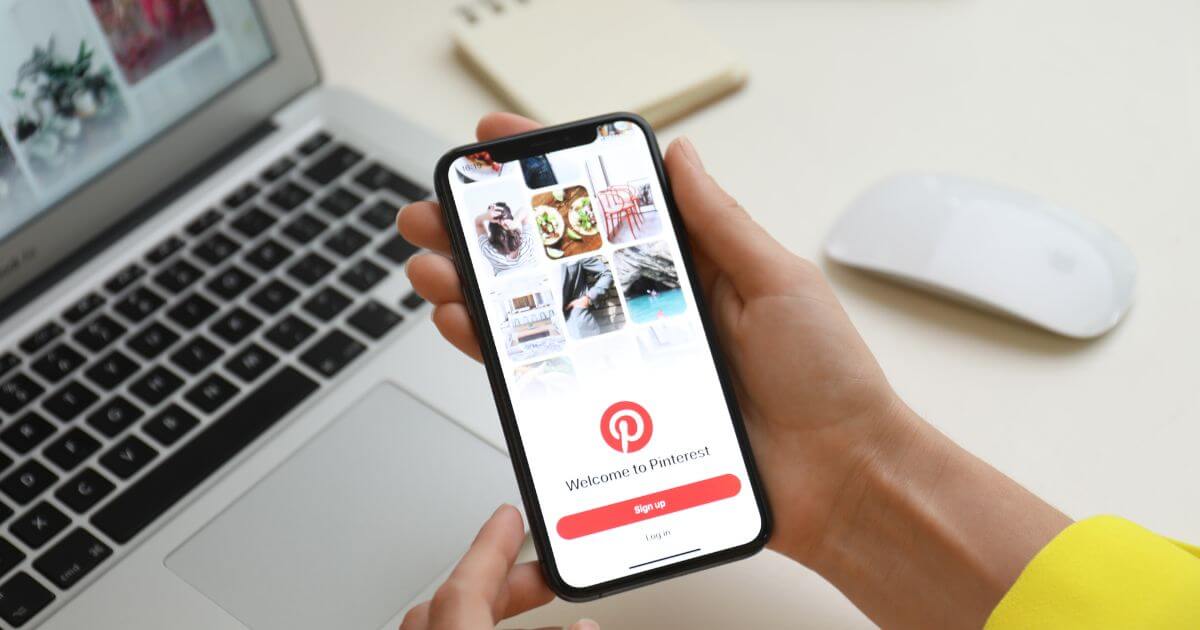How To Make Money on Pinterest for Beginners (2024)

This post may contain affiliate links which means that sproutinue.com may make a small commission at no extra cost to you. We only promote products that we love and feel will benefit our readers. Please read our Disclosure Policy for more information.
Picture this: after a long, exhausting day, you’re finally on your cozy couch sipping coffee while scrolling through Pinterest.
What if I told you you could leverage the platform to make extra cash?
Pinterest boasts 498 million users monthly, so it’s no wonder businesses, brands, and companies are using it to drive more website traffic and increase sales.
I’m sure by now you’re wondering if making money on Pinterest is possible without the drama and attention similar social media platforms possess.
Well, you’ve come to the right place. I’ll share insightful strategies for making money on Pinterest with and without a blog.
I’ll also explore other potential income sources, like becoming a Pinterest VA, linking your e-commerce store to the platform, and affiliate marketing.
How To Make Money on Pinterest WITH a Blog
Are you a writer looking to broaden your horizons through Pinterest? Or maybe you’re a novice writer still learning the ropes about blogging?
Whichever it is, blogging and Pinterest are like peanut butter and jelly. They complement each other and are often paired to create an extensive online presence.
Let’s not rule out the possibility of making money on Pinterest without a blog. That works, too, but I’ll cover it later in the article.
For now, let’s dive into the details of using Pinterest to drive a bucketload of traffic to your blog.
1. Start Your Blog
Starting a blog may seem scary initially, but it couldn’t be easier. Stop spending time thinking about it. Just get started!
Are you looking for a free or self-hosting blog? Having no startup capital shouldn’t limit your blog dream. Plenty of sites like WordPress and Blogger allow you to set up your blog for free.
However, I often discourage free-mode blogging because it has numerous limitations, especially when you try to monetize your blog after a while.
Some common downsides of free blogging platforms include:
- Limited design and customization options
- Slow site speed
- Limited control over ads that display on your blog
- Restricted monetization options
- Less professional domain names
Want to avoid the above limitations? Create a self-hosting blog on Hostinger for just $2.99 monthly.
Hostinger offers numerous benefits, including a free domain in the first year, a free 1-click WordPress installation, and 150 designer-crafted templates.
You’ll also get Google Analytics integration, marketing integrations, and an AI website creation tool to help you create a decent blog.
Free is more desirable, but paying for a premium package to start your blog will be helpful in the long run if you want to monetize it.
Don’t wait. Put in the work on Hostinger now to unlock your blog’s full potential.
Once your blog is running, choose a niche and create compelling content that resonates with your target audience.
2. Create a Pinterest Business Account
Now that you’ve successfully set up your blog and published a few posts, let’s set up your Pinterest account.
Pinterest’s policies require creating a business account if you intend to use the platform commercially.
What about your personal account that already has 300 followers? You can convert it into a business account without losing your pins and followers.
Unlike a personal account, a business account has features like promoted pins, rich pins, and Pinterest Analytics, which you can use to promote your products.
Setting up a business account is easy. You can kick off in the following steps:
- Click “sign up” then “create a business account.”
- Enter your email address, password, and age
- Create your profile
- Add a description of your business
- Choose whether to run ads and voila!
If you want to convert your personal account into a business account, follow the steps here.
Adding relevant keywords to your profile optimizes it for SEO and makes you more visible to potential clients.
3. Create Some Boards
If you’re new to Pinterest, a Pinterest board is a collection of related pins. Saving other people’s pins drives traffic to your account and helps people start noticing you.
Multiple boards help widen your reach while optimizing your account’s organization. Have at least ten boards with over 15 relevant pins.
Use keywords and relevant hashtags in your boards’ titles and descriptions to increase visibility.
Your boards’ names can be a deal maker or breaker, so you must choose them wisely. Not sure how to name your boards? Simply use Pinterest’s search bar to find relevant keywords for your niche.
For instance, if your niche is about working from home, here are some nice board names:
- Work-life balance strategies
- WFH tips and tricks
- Home office inspos
If your content is about home decor, you can use the following board names:
- Dream home aesthetic
- DIY home decor ideas
- Minimalist decor inspiration
4. Start Pinning
Saving other people’s pins won’t cut it. You must create your own content to stay relevant and drive traffic to your account.
Pinterest has in-built tools you can use to create your pins. However, Canva works better for me because it has more advanced design tools.
Furthermore, you can use Canva to create images that integrate smoothly with other social media platforms, not just Pinterest.
Ensure the text on your pins is legible and the colors blend seamlessly with your niche.
For instance, you can use white with a pop of gold for a modern monochrome home decor niche. Green and brown is the perfect combo for travel and adventure.
5. Join Group Boards and Tailwind Tribes
Joining group boards on Pinterest has immense advantages. For one, it increases visibility since group boards have a wider reach than individual boards.
Furthermore, joining group boards fosters teamwork and collaboration with other creators on Pinterest. You can use this exposure to tap into other influencers’ audiences.
Another perk of group boards is the diversity they offer. Group boards usually cover different topics within a particular niche. Therefore, joining one can widen your reach within your target audience.
Tailwind offers another opportunity to engage with people with similar interests and drive more traffic to your content.
Tailwind has community-based forums, similar to subreddits. These are called Tribes, and you can use them to improve your Pinterest presence.
For example, when you add a pin to a Tailwind tribe, other tribe members can view and repin your post. If someone repins your pins, you’ll become more visible to their followers.
6. Monetize Your Blog
Now that your Pinterest account is driving traffic to your blog, finding ways to monetize this traffic is the next step. Here’s how to do that:
Affiliate Marketing
Becoming an affiliate with brands, companies, and businesses is one of the most common ways to make money with a blog. Only this time, you have a secret weapon: your Pinterest account.
Affiliate marketing involves promoting a product or service and earning commissions when someone purchases it through your unique link. Commissions usually range from 2%-10%.
Search for affiliate programs within your niche and partner with them.
For instance, if your niche is health and fitness, you can partner with gyms and companies to sell fitness equipment, gym memberships, and workout routines.
From there, create a blog post about health and fitness, then add your affiliate link. Next, create a pin illustrating the importance of fitness, then link it to the blog post.
When someone clicks your pin, they’ll be redirected to your blog post and encouraged to click the affiliate link.
Still trying to figure out how to get started? Making Sense of Affiliate Marketing offers an online course that will walk you through the basics of monetizing your blog through affiliate marketing.
Selling Your Own Merchandise
Using your blog to sell your own products is another way to make money online. You could offer eBooks, courses, and even pin templates.
Honestly, there’s no limit on what to sell as long as it relates to your niche and target audience. If you don’t know where to start, consider writing a short course on starting a blog.
Let your story speak for itself, and bring in some moolah!
Running Paid Ads
Looking for another way to reach your blog’s potential? Partnering with Google Adsense, Mediavine, and Ezoic to run paid ads is a fantastic strategy.
Mediavine’s minimum traffic requirement is 50,000 monthly sessions, but it recently introduced Journey, which requires 10,000 sessions. You can achieve this blog traffic with Pinterest.
How To Make Money on Pinterest WITHOUT a Blog (Affiliate Marketing)
If you’re not an avid writer, I’m sure by now you’re almost giving up on this article because of all that blog talk.
While blogging is the most common way to make money on Pinterest, there are other avenues you can go through if you don’t fancy blogging.
Affiliate marketing is one way to go about it. Many people will tell you you need a blog to succeed as an affiliate, but I’m here to illuminate an alternative perspective.
Here’s how to make money on Pinterest without a blog:
1. Select a Profitable Niche
Working in different niches exposes you to various audiences. However, focusing on one is useful in establishing yourself as an expert.
Here are some profitable niche ideas on Pinterest:
- Home Decor
- Personal Finance
- Travel
- Lifestyle
- Food
- Healthy living
Numerous niches are worth exploring; the above is just the tip of the iceberg. Utilize the internet to search for the most profitable niches and products you can sell.
2. Create Your Pinterest Profile
Now that you have a niche in mind, head over to Pinterest and create a business account using your email address.
Remember to optimize your profile for SEO by adding related keywords. Create new boards and join group boards to boost visibility and interact with other creators.
3. Choose an Affiliate Program
The next step is to choose an appropriate affiliate program related to your niche and create a unique affiliate link that you’ll use to drive sales and earn commissions.
Many affiliate programs are out there, and a quick Google search will help you find the right one. You can also register for several programs to maximize your income.
You can approach companies within your niche with an affiliate proposition or utilize the following programs:
- Rakuten Advertising
- Amazon Associates
- eBay Partner Network
- Fiverr
4. Create Pins and Include Your Affiliate Link
Create pins related to the products or services you’re promoting. You can use Pinterest’s inbuilt tools or explore Canva’s vast options.
Once you create your pins, incorporate your affiliate link so that when a user clicks the pin, they’re directed to the sales page.
Remember to give users a disclaimer stating you’ll earn a commission when they click your links and make purchases.
Replying to comments and DMs is a fantastic way to keep your audience engaged and encourage loyalty.
5. Rinse, Repeat
Consistency in creating high-quality pins and interacting with your audience is crucial for success. Don’t stop after the first pin. Create more and add your affiliate link to drive more sales.
Stay vigilant for hot-selling products and be updated with trends to refine your strategies and increase commissions.
How To Make Money on Pinterest With an E-Commerce Store
Do you have an e-commerce store on Etsy? Or maybe you have a website where you sell items related to your niche?
You can use Pinterest to drive traffic to your e-commerce store and boost sales. In fact, Pinterest has recently added numerous shopping features to help you get ahead.
Here’s a step-by-step process of making money on Pinterest with an e-commerce store:
1. Launch Your Store
This is the first step to success if you haven’t established your e-commerce store. Head to Etsy, Shopify, or WooCommerce to get started.
Create your profile, optimize it for SEO, and add a list of your products. Etsy charges $0.20 per listing, while Shopify charges $5 monthly for a starter seller account.
Remember to add clear photos of your products and detailed descriptions so potential buyers know what they’re purchasing.
Also, incorporate keywords into your descriptions to improve your product rankings in the search engine.
2. Create a Pinterest Business Account
As mentioned, you must create a business account to make money on Pinterest. You can convert your personal account to a business one to retain your pins and followers.
Also, add keywords to your pins to make them more visible. Creating high-quality pins helps capture your target audience.
You can further widen your reach by joining group boards and actively posting new pins on the boards.
3. Integrate Your e-Commerce Shop With Pinterest
Once both are set up, link your e-commerce store to your Pinterest business account. Pinterest offers seamless integrations with the following platforms:
- Shopify
- Salesforce Commerce Cloud
- WooCommerce
- Adobe Commerce
Once you connect your Pinterest business account to your storefront, Pinterest automatically converts your catalog into product pins. How great is that!
These pins are visible to all Pinterest users, and you can use them to create shopping campaigns to promote your products.
Furthermore, Pinterest has a feature called Pinterest API, which provides detailed data on how your store is performing and how many people are purchasing your products.
4. Join the Verified Merchant Program
People always shop from brands and businesses they trust.
By joining the verified merchant program, you receive an exclusive badge that shows the Pinterest team vetted your brand. This boosts buyers’ confidence and assures them you’re legit.
The program also ensures your products appear at the top of search results, especially for users who are searching for new brands.
Another perk of being a member of this elite program is access to exclusive features like hosted checkout and merchant details.
You must meet the following requirements to be eligible for the verified merchant program:
- Your Pinterest business account must be 3+ months old
- You must claim your account
- Your account must have a profile picture and a detailed description in the “About” section.
- You must reside in Australia, Brazil, Austria, France, Canada, Germany, Mexico, the Netherlands, Switzerland, the UK, and the US.
5. Launch Campaigns to Scale Your Returns
Pinterest offers two ways to put your products out there: shopping and collection ads.
Shopping Ads:
This advertising feature by Pinterest promotes your products to users who are viewing and searching for similar content.
When you link your shop to your Pinterest account, this feature converts your product catalog into product pins and includes detailed information, like price, description, and availability.
You can use these product pins to launch campaigns tailored toward your target audience.
The shopping ads feature also lets you view real-time data on your campaigns’ performance. This data is useful in optimizing campaigns and refining your marketing strategies.
Collection Ads:
Unlike shopping ads, collection ads try to fit multiple products into one ad unit. It may arrange your product pins in a grid, with a short video or large image at the top.
This strategy exposes users to multiple products from your catalog rather than just one. It’s very effective in promoting sales.
How To Make Money on Pinterest as a Pinterest VA
Still looking for ways to make money on Pinterest? Working as a Pinterest VA is an excellent way to get paid to pin.
While Pinterest is a fantastic place to drive traffic to your blog and online store, many individuals and businesses don’t know how to use it.
People are so used to platforms like Instagram and Twitter that they don’t know how to monetize Pinterest. This is where Pinterest virtual assistants come in!
Your roles as a Pinterest VA would include the following:
- Creating high-quality pins
- Coming up with marketing strategies for Pinterest
- Engaging with followers
- Fostering relationships with other creators and influencers
- Optimizing profile and pin descriptions for SEO
If you know how Pinterest works, you can easily make a living this way.
Even if you don’t, there are plenty of online resources, including the online course by Pinterestva.com, which helps you learn the ropes and start making money in no time.
Follow the following simple steps if you want to make money as a Pinterest VA:
1. Create Your Portfolio
There’s no better way to show your skills than by creating a portfolio that speaks for itself. Start by creating your Pinterest account and becoming your first customer.
Create an eye-catching profile and compelling pins that persuade potential clients to give you a chance.
If you want to appeal to businesses and brands, consider creating a Pinterest Business account and incorporating shopper ads and campaigns to showcase exactly how you’ll use the platform to maximize their profits.
On the other hand, if your target audience is people looking to drive traffic to their blogs, you can create a free blog to act as a sample, then link it to your Pinterest and employ strategies to make the magic happen.
If you don’t like the idea of working for yourself and toward a non-existent blog or e-commerce store, you can offer free services to a friend to capture real-life results in your portfolio.
2. Scout for Gigs
Now that your portfolio showcases your exceptional Pinterest VA skills, don’t let it collect dust. Rather, put yourself out there for potential clients to notice you.
One way to land gigs is by sending cold emails to clients you think would benefit from a Pinterest presence.
It’s as simple as that. Tell them the benefits of Pinterest and how you can turn the narrative around. Don’t forget to attach your portfolio.
You can also scout for Pinterest VA gigs on job boards like Indeed, LinkedIn, or Upwork. Simply search “Pinterest virtual assistant jobs,” find something that piques your interest, and then apply.
Facebook Groups are always resourceful if you’re looking for a product or service. In the same way, you can use them to find Pinterest VA jobs.
Join groups you’re interested in, engage with potential clients, and build relationships while tactfully marketing your VA skills.
Once you land clients, encourage them to refer you to their networks. If you successfully provide high-quality services, you won’t have to ask them to refer you; they’ll do it automatically.
3. Improve Your Skills
Like any other job, you must improve your skills to remain relevant as a Pinterest VA. It can also be a fantastic strategy to increase your earnings in the future.
Learning is a continuous path whether you’re new or have years of experience. There are plenty of resources online you can use to improve your skills.
I also recommend Kristin Larsen’s course, Become a Pinterest VA Today! Kristin quit her 9-5 because she was constantly frustrated by working for someone else.
She wanted to be her own boss and call the shots. Her passion drove her to start a Pinterest VA career and help others do the same through her course.
You can check out her free workshop to determine if working as a Pinterest VA is the right path.
Other Ways To Make Money on Pinterest
Here are some other ways to make money on Pinterest:
1. Partner With Smaller Creators
You can promote smaller creators like social media influencers do. You can help them improve their visibility by:
- Showcasing their pins on your profile
- Inviting them to collaborate in a group board with you
- Repinning their content
- Sharing their work outside Pinterest, e.g., on social media platforms
- Liking and commenting on their content
Smaller creators may pay less than businesses, brands, and companies, but they are an excellent way to maximize your income.
You can always combine this income idea with others, like working as a Pinterest VA or driving traffic to your blog.
2. Create Online Courses or eBooks
Still looking for ways to make money on Pinterest? If so, consider creating online courses or eBooks.
The best part is you can create a course on anything as long as you’re an expert. For instance, once your Pinterest business account generates revenue, you can write a course on starting a Pinterest account as a beginner.
Outline the chapters and create high-quality content, incorporating visual elements like videos, images, and worksheets to make the content more appealing.
From there, upload your content on your website or sites like Udemy, Amazon Kindle Direct, and Teachable.
Next, attach a link to your pins so your audience will be directed to your sales page when they click a pin.
3. Work as a Pinterest Consultant
Another way to monetize your Pinterest expertise is by becoming a consultant. This involves providing strategic guidance and marketing strategies to your clients.
You may also need to perform Pinterest audits and analyze performance.
Now, don’t confuse this role with working as a Pinterest VA.
A Pinterest consultant offers guidance on improving visibility on Pinterest, while a Pinterest VA handles day-to-day administrative duties like creating pins and engaging with followers.
Frequently Asked Questions
Can You Get Paid on Pinterest?
Pinterest doesn’t pay you money directly, but you can use it to drive traffic to your blog, e-commerce store, website, or sales page to make more sales.
Does Pinterest Pay Creators?
No, Pinterest doesn’t pay creators for creating content on the platform, however large their following is.
However, you can use your expertise on Pinterest to work as a VA or partner with other creators looking to expand their horizons.
You can also leverage your following to drive sales to your blog, website, e-commerce store, or any other external place where you sell merch.
Creating sponsored content and affiliate marketing are fantastic ways to make money on Pinterest.
Whichever avenue you choose, organize logistics and payment terms directly with your clients outside the platform.
How Many Followers Do You Need on Pinterest to Earn Money?
You don’t need a specific number of followers to make money on Pinterest. Regardless of your following, you’ll likely make sales if you employ effective affiliate marketing strategies.
However, in some cases, your following influences the revenue and programs you can use. For instance, Mediavine requires a minimum of 50,000 monthly traffic to earn from ads. Mediavine recently introduced Journey, which requires 10,000 sessions a month.
How Do You Get Your First 1,000 Followers on Pinterest?
Getting your first 1,000 followers may seem daunting, but you can pull it off through the following tips:
- Create an eye-catching profile and incorporate all relevant keywords and hashtags
- Curate at least ten boards to show your audience you’re consistent and active
- Add a friendly profile photo to earn your audience’s trust
- Add a compelling cover image
- Research your target audience and create high-quality content that resonates with them.
- Share your boards and pins outside Pinterest
Final Thoughts
Overall, making money on Pinterest is easy with the right strategies. Knowing yourself also plays a huge role here.
For instance, don’t try setting up a blog if you don’t like writing. You can explore other options like eCommerce or affiliate marketing.
Finally, don’t be afraid to stack different money-making ventures and promote your pins outside Pinterest to increase your following and maximize income.




